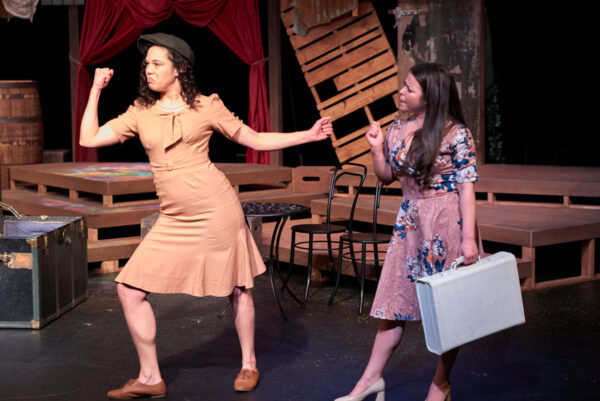
http://slog.thestranger.com/slog/archives/2013/01/12/its-saturday-dont-you-wanna-buy-something-you-dont-need
Review: “A Doll’s House” by Henrik Ibsen. Translation by Sean Patrick Taylor. Directed by Russ Banham. Produced by Seattle Shakespeare Company. With Jennifer Sue Johnson, Michael Patten, Peter Dylan O’Connor, Betsy Schwartz, and George Mount. Now through January 27, 2013 at the Center Theater at Seattle Center.
The start of a new year is obviously exciting…who knows what it will hold?!?!? And, it’s even more exciting for Theater Nerds for the exact same reason. Also, after nearly two months of having to make do with endless Christmas/Holiday themed shows of the sticky and sweet variety, it’s always a relief to get back to the meat and potatoes of January theater and the one zillion new shows that always open at the start of the year. By rough count, there’s about 22 shows or so opening this month ranging from the multi million dollar costing variety (The Book of Mormon) to the twee dollar costing variety in a basement in Ballard (Ghostlight’s Hamlet).
The month kicked off with something that falls in the upper middle of that range, Seattle Shakespeare Company’s non-Shakespearian entry for the year, their production of Henrik Ibsen’s classic 1879 play, “A Doll’s House”. For those of you who weren’t English/Theater majors in college or went to low rent high schools that didn’t include 19th Century Norwegian drama on its required reading list, “A Doll’s House” was Ibsen’s controversial masterpiece that shocked the world with its tale of a woman who turned her back on Family and Home to find her own identity without help from the established patriarchy, ie Father and/or Husband. It’s a bit less shocking to modern audiences, but in its day, “A Doll’s House” was the emotional equivalent of “Human Centipede”. It was banned in some locales, and others forced Ibsen to submit a different ending to the play requiring the female protagonist Nora Helmer to return to “Kinder und Küche”. If staged correctly, the power of Ibsen’s text still has resonance for contemporary audiences regardless of gender. The Establishment of the 19th Century was horrified by “A Doll’s House” not for it’s seemingly feminist stance, of which they had little concept, but because it dared to suggest the individual could reject the status quo. Independent thought and action still alarm the 21st Establishment…thinking about stuff and forming original opinions might result in people not buying Big Macs, iPhones or Hondas or not choosing between your two options for elected office. Non-conformity is still a renegade act.
“A Doll’s House” quickly establishes that Nora Helmer is a bit of a renegade. She’s the devoted wife of a middle class bank manager named Torvald and living in a nice middle class home with three appropriately spaced children, a nanny and a maid. She’s also a bit of a child herself, enjoying shopping excursions, snacking on bon bons and gleefully flopping on her genteel settee as she plots Christmas revelries. Nora is also excited because her husband’s recent job promotion means that more money will be flowing into her household and she can take control of a secret that she’s hiding from her husband. Early in their marriage, Torvald was mortally ill and only an extended rest in warmer climes would save his life. Unable to raise the money from her father, who was on his death bed, Nora secretly borrows a large sum of money from the shady Krogstad, forging her father’s name to secure the loan. Now that her own household’s fortunes are improving, Nora will be able to pay off that loan once and for all.
But, since this is 19th Century Norwegian drama, there are bumps in the road to Nora’s happiness. A childhood friend named Kristine Linde reenters Nora’s life asking for help in arranging for a job in Torvald’s bank. Torvald is happy to oblige since it means he now has a replacement for Krogstad, Nora’s shady lender, who also happens to be a childhood friend of Torvald’s who also happens to be on Torvald’s shit list because Krogstad is too familiar with his new boss (Torvald) in the office. (Yes, Torvald is that kind of uptight asshole.) Desperate to save his job, Krogstad threatens to expose Nora if she doesn’t change Torvald’s mind. Meanwhile, the Helmer’s devoted friend Dr. Rank is pining away for two reasons: He secretly love Nora and he’s dying from congenital syphilis inherited from his whoremongering father. Oh, and to complicate matters, Kristine Linde and Krogstad were an item back in the day and both are desperately seeking someone to love…
Yes, it’s classic 19th Century Norwegian Drama…and, a soap opera! Just like “Downton Abbey” but with more lutefisk and fjords!
All of the plot threads of “A Doll’s House” are wrapped up by the end of the last act and despite the fact Nora seems to be saved from her dilemma she’s still unresolved and not happy with Torvald’s reaction to her situation and the reasons WHY she did what she did…she forged a signature and borrowed money to save his life. Nora realizes she doesn’t love Torvald and she regrets not having her own sense of identity. She rejects Torvald’s offer of returning to their normal life and she makes the decision to leave him, their house and their children. She packs, and leaves, slamming shut the door on her old life as Torvald weeps.
Seattle Shakespeare Company has assembled a strong cast, one of Seattle’s best directors and a terrific line-up of designers and artists to stage this production and they’ve all done a fine job. It’s a strong and capable night of theater. Yet, I had a difficult time embracing this show and part of the problem is due to the tone of this particular production. Sean Patrick Taylor’s translation takes a very contemporary approach to the dialogue and attitudes of the characters. Nora at one point refers to “gobs and gobs of money” instead of the more usual translation of “lots and lots”. There is a certain lack of formality, that for me, hurts the original material and the time and setting of “A Doll’s House”. This is supposed to be Victorian Norway, not a provincial town in the United States circa last year. The casualness of the dialogue extends to the performances, particularly Jennifer Sue Johnson’s very physical interpretation of Nora as a flopping, bopping Raggedy Ann doll who flings herself with great abandon over the set. It’s a very literal interpretation of Nora as a “doll” and it’s a bit shocking and far too casual for the setting. Judging by the physicality, I’m guessing Ms Johnson is not wearing much of a corset under her costume…otherwise, she would be inflicting great harm against her internal organs as she flops about her sitting room! I can understand the need and the want of a director and a theater company to make a formal, old play relatable to modern audiences but straying too far in the direction of inappropriate informality hurts the intent and the focus of the play. Seattle Shakes’ production of “A Doll’s House” could use more starch in its bustle.
That being said, the cast and production team of this play do get the job done…despite the casualness of the presentation, the actors, including Ms Johnson who superbly plays all the many facets of Nora’s character and exhibits a great deal of strength and power in the final act of the play, give strong performances. Michael Patten has the very difficult role of Torvald, who is either cooing or condescending in his scenes with Nora, and manages to make Torvald both believable and humane. George Mount is a bit young to play Dr. Rank but the youthful zest he adds to a character doomed to an early death only aids in making the role more poignant. Peter Dylan O’Connor is very good as the “villain” Krogstad, adding subtle dimensions to a character that can easily fall into caricature in the hands of lesser actors. And, my favorite performance of the evening belongs to Betsy Schwartz and her firm but delicate portrayal of Kristine Linde, the character that represents the flip side of Nora, a woman who has faced personal hardships and had to work and fight to survive in a world without a man to “protect” her. Her quiet formality is a major strength of the show and her scenes with the equally wounded Krogstad are among this production’s highlights. Their relationship and its potential are just as intriguing as the larger issues facing Nora and her fate after she exits through that infamous door.
Oh, and a quibble about that door…it was sort of a boring door from a design perspective. It needs to be bigger, or askew, or at least have a proper door frame! Craig Wollam’s doll house like design has its charms, but the door is the least of them though it should be said that the “opening” of the dollhouse set in the beginning of the play was magical and highly appropriate to the tone and mood of the play. And, Pete Rush is known for his colorful contemporary costume designs (“Rent”) but his understated Victorian designs here are another highlight of this production.
Seattle Shakes’ “A Doll’s House” is a solid night of theater and can be recommended to fans of dramatic theater and classic material, with strong performances and a generally solid production overall, but personally, it was a doll I had a hard time embracing. My header is very accurate in describing this as “A Doll’s House” for the 21st Century, but is that necessarily a good thing?
















[…] Seattle Gay Scene […]